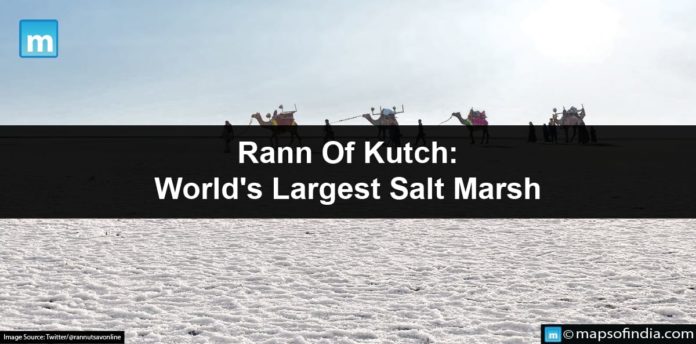The Rann of Kutch is a vast salt marsh in Gujarat, India’s Kutch district. It is the world’s largest salt marsh and one of its most distinctive ecosystems. The Rann of Kutch is a seasonal wetland that is flooded during the monsoon season and turns into a sparkling white desert during winter.
Significance
Many people in the region rely on the Rann of Kutch for a living. The salt from the Rann is extracted and used for various industrial and commercial applications. The Rann is also a famous tourist site, which helps the local economy. The Rann of Kutch is a place of outstanding natural beauty and ecological, cultural, and economic value. The Rann’s immense white expanse is breathtaking, especially in the winter when the salt marsh is dry. The Rann also has a diverse wildlife population, including flamingos, wild asses, and crocodiles.
Geography
The Rann of Kutch covers an area of nearly 7,000 square kilometres and is bounded west by the Arabian Sea and south by the Gulf of Kutch. The Rann of Kutch is split into two sections: the Great Rann of Kutch and the Little Rann of Kutch. The Great Rann of Kutch is a large white desert with a thin layer of salt covering it. The Little Rann of Kutch is a marshy environment teeming with wildlife such as flamingos, wild asses, and crocodiles.
Culture
The Rabaris, Banni, and Kutchi are among the tribal communities that live in the Rann of Kutch. These settlements have created a distinct culture in response to the severe environment of the Rann. Traditional crafts such as pottery, weaving, and embroidery are also popular in the Rann.
Flora and Fauna
Climate change, pollution, and overgrazing are environmental issues confronting the Rann of Kutch. The Rann is becoming drier and more saline due to climate change. Pollution from industry and agriculture is also wreaking havoc on the Rann ecology. Livestock overgrazing is destroying the Rann’s vegetation and leading to soil erosion.
The Rann of Kutch is home to a variety of wildlife. The vegetation and wildlife of the Rann of Kutch have adapted to the severe conditions of the salt marsh. For example, many plants have grown thick, fleshy leaves to store water and protect them from the sun and salt. Many animals are also nocturnal, which means they are most active at night when temperatures are lower.
The Rann of Kutch is a one-of-a-kind and vulnerable ecosystem home to diverse and fascinating flora and wildlife. It is critical to save this ecosystem and its inhabitants for future generations of tribal societies such as the Rabaris, Banni, and Kutchi. The Rann of Kutch is a popular tourist attraction, particularly during winter when the Rann turns into a sparkling white desert. Camel safaris, jeep safaris, and cultural performances are among the activities available to visitors in the Rann.




